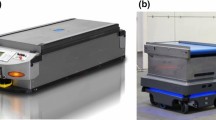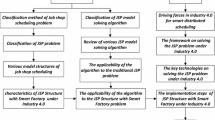Abstract
This paper analyses the workload control in manufacturing systems under continuous order release by a simulation environment. The main issues investigated in the proposed research regard the selection of the order to release, among the orders in a pre-shop queue, the workload computation based on the routing of the orders and the workload norm. The simulations are conducted changing the number of bottleneck in the manufacturing system tested. The simulation results highlight how two of the proposed policies lead to better performance measures compared to a policy proposed in literature. The main contributions regard the higher improvements for the due date performance (average lateness and percentage of orders in delay) introducing a pre-shop queue management balancing the workload and the computation of the corrected workload considering the average utilization of the work centers.





Similar content being viewed by others
References
Atwater JB, Chakravorty SS (2002) A study of the utilization of capacity constrained resources in drum-buffer-rope systems. Prod Oper Manag 11(2):259–273
Bertrand JWM, Van Ooijen HPG (2002) Workload based order release and productivity: a missing link. Prod Plan Control 13:665–678
Blackstone JH, Cox JF (2002) Designing unbalanced lines—understanding protective capacity and protective inventory. Prod Plan Control 13(4):416–423
Breithaupt JW, Land J, Nyhuis P (2002) The workload control concept: theory and practical extensions of load oriented order release. Prod Plan Control 13(7):625–638
Centeno MA, Reyes MF (1998) So you have your model: what to do next a tutorial on simulation output analysis. In: Proceedings of the 1998 winter simulation conference 1998
Fernandes NO, Carmo-Silva S (2011) Workload control under continuous order release. Int J Prod Econ 131:257–262
Fernandes NO, Land MJ, Carmo-Silva S (2014) Workload control in unbalanced job shops. Int J Prod Res 52(3):679–690
Fredendall LD, Divesh O, Patterson JW (2010) Concerning the theory of workload control. Eur J Oper Res 201:99–111
Land MJ, Gaalman GJC (1996) Workload control concepts in job shops: a critical assessment. Int J Prod Econ 46–47:535–538
Melnyk SA, Ragatz GL (1989) Order review/release: research issues and perspectives. Int J Prod Res 27(7):1081–1096
Missbauer H (2009) Models of the transient behaviour of production units to optimize the aggregate material flow. Int J Prod Econ 118(2):387–397
Oosterman BJ, Land MJ, Gaalman GJC (2000) The influence of shop characteristics on workload control. Int J Prod Econ 68(1):107–119
Stevenson M, Hendry LC, Kingsman BG (2005) A review of production planning and control: the applicability of key concepts to the make-to-order industry. Int J Prod Res 43(5):869–898
Stevenson M, Silva C (2008) Theoretical development of workload control methodology: evidence from two case studies. Int J Prod Res 46(11):3107–3131
Thürer M, Silva C, Stevenson M, Land MJ (2012) Improving the applicability of workload control: the influence of sequence dependent set-up times on workload controlled job shops. Int J Prod Res 50(22):6419–6430
Thürer M, Silva C, Stevenson M (2014) Controlled order release: a performance assessment in job shops with sequence dependent set-up times. Prod Plan Control 25(7):603–615
Thürer M, Qu T, Stevenson M, Maschek T, Godinho Filho M (2014) Continuous workload control order release revisited: an assessment by simulation. Int J Prod Res 52(22):6664–6680
Thürer M, Silva C, Stevenson M (2011) Optimising workload norms: the influence of shop floor characteristics on setting workload norms for the workload control concept. Int J Prod Res 49(4):1151–1171
Thürer M, Stevenson M, Silva C, Land MJ, Fredendall LD (2012) workload control (wlc) and order release: a lean solution for make-to-order companies. Prod Oper Manag 21(5):939–953
Thürer M, Land MJ, Stevenson M, Fredendall LD, Godinho Filho M (2014) Concerning workload control and order release: the pre-shop pool sequencing decision. Prod Oper Manag. doi:10.1111/poms.12304
Zafar H, Zuhairi M, Harle D, Andonovic I (2012) A review of techniques for the analysis of simulation output. IETE Technical Review 29(3):223–228
Author information
Authors and Affiliations
Corresponding author
Rights and permissions
About this article
Cite this article
Renna, P. Workload control policies under continuous order release. Prod. Eng. Res. Devel. 9, 655–664 (2015). https://doi.org/10.1007/s11740-015-0639-2
Received:
Accepted:
Published:
Issue Date:
DOI: https://doi.org/10.1007/s11740-015-0639-2




